What Do Students Know about Rivers and Their Management? Analysis by Educational Stages and Territories
Abstract
1. Introduction
2. Materials and Methods
2.1. Survey Design and Distribution
2.2. Assessment of Survey Responses
2.3. Data Analysis
3. Results
3.1. Ecosystem Concept of Rivers
3.2. River Management
4. Discussion
4.1. Ecosystem Concept of Rivers
4.2. River Management
4.3. Differences among Educational Levels and Territories
4.4. Final Remarks
Author Contributions
Funding
Acknowledgments
Conflicts of Interest
References
- Rice, S.P.; Lancaster, J.; Kemp, P. Experimentation at the interface of fluvial geomorphology, stream ecology and hydraulic engineering and the development of an effective, interdisciplinary river science. Earth Surf. Process. Landf. 2010, 35, 64–77. [Google Scholar] [CrossRef]
- Hynes, H.B.N. Edgardo Baldi Memorial Lecture. The stream and its valley. Verh. Int. Ver. Theor. Angew. Limnol. 1975, 19, 1–15. [Google Scholar]
- Junk, W.; Bayley, P.B.; Sparks, R.E. The flood pulse concept in river-floodplain systems. In Proceedings of the International Large River Symposium (LARS); Dodge, D.P., Ed.; Dept. of Fisheries and Oceans: Ottawa, ON, Canada, 1989; pp. 110–117. [Google Scholar]
- Newbold, J.D.; Elwood, J.W.; O’Neill, R.V.; Winkle, W.V. Measuring nutrient spiralling in streams. Can. J. Fish. Aquat. Sci. 1981, 38, 860–863. [Google Scholar] [CrossRef]
- Vannote, R.L.; Minshall, G.W.; Cummins, K.W.; Sedell, J.R.; Cushing, C.E. The river continuum concept. Can. J. Fish. Aquat. Sci. 1980, 37, 130–137. [Google Scholar] [CrossRef]
- Moss, B.R. Ecology of Fresh Waters: Man and Medium, Past to Future; John Wiley & Sons: Hoboken, NJ, USA, 2009. [Google Scholar]
- Dresti, C.; Becciu, G.; Saidi, H.; Ciampittiello, M. The hydromorphological state in mountain rivers subject to human impacts: A case study in the north-west of Italy. Environ. Earth Sci. 2016, 75, 1–11. [Google Scholar] [CrossRef]
- Haase, P.; Hering, D.; Jähnig, S.C.; Lorenz, A.W.; Sundermann, A. The impact of hydromorphological restoration on river ecological status: A comparison of fish, benthic invertebrates, and macrophytes. Hydrobiologia 2013, 704, 475–488. [Google Scholar] [CrossRef]
- Ladrera, R.; Prat, N. Las políticas europeas y el consenso científico en materia de gestión y conservación de aguas no llegan a la escuela. In Proceedings of the IX Congreso Ibérico de Gestión y Planificación del Agua, Valencia, España, 7–9 September 2016; Fundación Nueva Cultura del Agua (FNCA): Valencia, España, 2016; pp. 637–648. [Google Scholar]
- Rodríguez-Lozano, P.; Woelfle-Erskine, C.; Bogan, M.T.; Carlson, S.M. Are non-perennial rivers considered as valuable and worthy of conservation as perennial rivers? Sustainability 2020, 12, 5782. [Google Scholar] [CrossRef]
- Ruiz-Villanueva, V.; Díez-Herrero, A.; García, J.A.; Ollero, A.; Piégay, H.; Stoffel, M. Does the public’s negative perception towards wood in rivers relate to recent impact of flooding experiencing? Sci. Total Environ. 2018, 635, 294–307. [Google Scholar] [CrossRef]
- Piégay, H.; Gregory, K.J.; Bondarev, V.; Chin, A.; Dahlstrom, N.; Elosegi, A.; Gregory, S.V.; Joshi, V.; Mutz, M.; Rinaldi, M.; et al. Public perception as a barrier to introducing wood in rivers for restoration purposes. Environ. Manag. 2005, 36, 665–674. [Google Scholar] [CrossRef]
- Ladrera, R.; Rieradevall, M.; Prat, N. Macroinvertebrados acuáticos como indicadores biológicos: Una herramienta didáctica. Ikastorratza E-Rev. Didáctica 2013, 11, 1–18. [Google Scholar]
- Stough, T.; Ceulemans, K.; Lambrechts, W.; Cappuyns, V. Assessing sustainability in higher education curricula: A critical reflection on validity issues. J. Clean. Prod. 2018, 172, 4456–4466. [Google Scholar] [CrossRef]
- Giangrande, N.; White, R.M.; East, M.; Jackson, R.; Clarke, T.; Coste, M.S.; Penha-Lopes, G. A competency framework to assess and activate education for sustainable development: Addressing the un Sustainable Development Goals 4.7 challenge. Sustainability 2019, 11, 2832. [Google Scholar] [CrossRef]
- Covitt, B.; Gunckel, K.; Anderson, C. Students’ developing understanding of water in environmental systems. J. Environ. Educ. 2009, 40, 37–51. [Google Scholar] [CrossRef]
- Tilbury, D. Environmental education for sustainability: Defining the new focus of environmental education in the 1990s. Environ. Educ. Res. 1995, 1, 195–212. [Google Scholar] [CrossRef]
- Díez, J. El Agua: Una herramienta clave en la educación para el desarrollo sostenible. Rev. Bras. Pesqui. Educ. Ciências 2014, 14, 109–123. [Google Scholar]
- Hicks, D.; Holden, C. Exploring the future: A missing dimension in environmental education. Environ. Educ. Res. 1995, 1, 185–193. [Google Scholar] [CrossRef]
- Martínez-Peña, M.B.; Gil-Quílez, M.J. El río: Un tema cotidiano para el aula de ciencias. Enseñanza Cienc. 2014, 22, 257–266. [Google Scholar]
- Díez, J. De Tales a Dalton. A vueltas con el ciclo del agua. In Proceedings of the X Congreso Ibérico de Gestión y Planificación del Agua, Coimbra, Portugal, 6–8 September 2018; Fundación Nueva Cultura del Agua (FNCA): Coimbra, Portugal, 2018; pp. 1–14. [Google Scholar]
- González, F.; Fernández, G. Potencialidades y limitaciones de las analogías elaboradas por estudiantes de magisterio para representar las aguas subterráneas. Ensen. Cienc. Tierra 2012, 20, 229–238. [Google Scholar]
- Gunckel, K.L.; Covitt, B.A.; Salinas, I.; Anderson, C.W. A learning progression for water in socio-ecological systems. J. Res. Sci. Teach. 2012, 49, 843–868. [Google Scholar] [CrossRef]
- Márquez, C.; Bach, J. Una propuesta de análisis de las representaciones de los alumnnos sobre el ciclo del agua. Ensen. Cienc. Tierra 2007, 15, 280–286. [Google Scholar]
- Ben-zvi-Assaraf, O.; Orion, N. A study of junior high students’ perceptions of the water cycle. J. Geosci. Educ. 2005, 53, 366–373. [Google Scholar] [CrossRef]
- Dickerson, D.L.; Penick, J.E.; Dawkins, K.R.; Van Sickle, M. Groundwater in science education. J. Sci. Teacher Educ. 2007, 18, 45–61. [Google Scholar] [CrossRef]
- Gil-Quílez, M.J.; Martínez-Peña, M.B. Construcción del modelo de río: Paso previo a la reflexión sobre gestión fluvial. In Investigación y Transferencia Para Una Educación en Ciencias: Un Reto Emocionante; De Las Heras Pérez, M.A., Lorca Marín, A.A., Vázquez Bernal, B., Wamba Aguado, A.A., Jiménez Pérez, R., Eds.; Universidad de Huelva Publicaciones: Huelva, España, 2014; pp. 269–276. [Google Scholar]
- MECD. Real Decreto 1105/2014, de 26 de diciembre, por el que se establece el currículo básico de la Educación Secundaria Obligatoria y del Bachillerato; Ministerio de Educación Cultura y deporte: Madrid, España, 2015. [Google Scholar]
- MECD. Real Decreto 126/2014, de 28 de Febrero, por el que se establece el currículo básico de la Educación Primaria; Ministerio de Educación Cultura y deporte: Madrid, España, 2014. [Google Scholar]
- Heras, F. Educación para el uso sostenible del agua. Transatl. Educ. 2011, 8, 37–44. [Google Scholar]
- Marcén, C. El agua: Argumento Educativo en la Enseñanza Obligatoria y en el Sistema Social. Ph.D. Thesis, Universidad de Zaragoza, Zaragoza, España, 2010. [Google Scholar]
- Anderson, M.J.; Gorley, R.N.; Clarke, K.R. PRIMER + for PERMANOVA: Guide to Software and Statistical Methods; PRIMER-E. Ltd.: Plymouth, UK, 2008. [Google Scholar]
- Clarke, K.R.; Gorley, R.N. PRIMER v6: User Manual/Tutorial; PRIMER-E Ltd., Plymouth Marine Laboratory: Plymouth, UK, 2006. [Google Scholar]
- Díez, J.R.; Sarriegi, M.; Elosegi, A. La madera muerta y la ecología fluvial: Ecología y gestión. In Procesos Hidrosedimentarios en Sistemas Fluviales; Batalla, R., Tena, A., Eds.; Milenio: Lleida, España, 2016; pp. 245–275. [Google Scholar]
- European Commission. Water Framework Directive 2000/60/EC of the European Parliament of the Council of 23 October 2000 Establishing a Framework for Assemblage Action in the Field of Water Policy; European Commission: Brussels, Belgium, 2000. [Google Scholar]
- Bonada, N.; Prat, N.; Resh, V.H.; Statzner, B. Developments in aquatic insect biomonitoring: A comparative analysis of recent approaches. Annu. Rev. Entomol. 2006, 51, 495–523. [Google Scholar] [CrossRef]
- Prat, N.; Munné, A. Biomonitoreo de la calidad del agua en los ríos ibéricos: Lecciones aprendidas. Limnetica 2014, 33, 47–64. [Google Scholar]
- Castro-López, D.; Rodríguez-Lozano, P.; Arias-Real, R.; Guerra-Cobián, V.; Prat, N. The influence of riparian corridor land use on the pesquería river’s macroinvertebrate community (N.E. Mexico). Water 2019, 11, 1930. [Google Scholar] [CrossRef]
- Soria, M.; Gutiérrez-Cánovas, C.; Bonada, N.; Acosta, R.; Rodríguez-Lozano, P.; Fortuño, P.; Burgazzi, G.; Vinyoles, D.; Gallart, F.; Latron, J.; et al. Natural disturbances can produce misleading bioassessment results: Identifying metrics to detect anthropogenic impacts in intermittent rivers. J. Appl. Ecol. 2020, 57, 283–295. [Google Scholar] [CrossRef]
- Prat, N.; Rieradevall, M.; Fortuno, P.; Ladrera, R.; Verkaik, I.; Becerra, M.; Menendez, S. Riu.Net Application: Citizen science in rivers. In Proceedings of the COWM2016–International Conference on Citizen Observatories for Water Management, Venice, Italy, 7 June 2016; pp. 7–9. [Google Scholar]
- Poff, N.L.; Zimmerman, J.K.H. Ecological responses to altered flow regimes: A literature review to inform the science and management of environmental flows. Freshw. Biol. 2010, 55, 194–205. [Google Scholar] [CrossRef]
- Ladrera, R.; Prat, N. Changes in macroinvertebrate community and biotic indices associated with stream flow regulation and wastewater inputs in sierra cebollera natural park (La Rioja, Northern Spain). Limnetica 2013, 32, 353–372. [Google Scholar]
- Masip, I. Aproximación a la problemática de la pervivencia de los hidromitos como principal obstáculo para avanzar hacia una nueva cultura del agua. Arx. Cienc. Soc. 2013, 29, 115–128. [Google Scholar]
- Peñas, V.; Masip, I. Destejiendo Tópicos del Agua; Solidaridad Internacional/Fundación Tomás y Valiente: Bilbao, España, 2011. [Google Scholar]
- Peño, G. Percepción del Ebro y Sus Crecidas en Zaragoza y en Municipios Ribereños. Master’s Thesis, Universidad de Zaragoza, Zaragoza, España, 2018. [Google Scholar]
- Ollero, A. Territorio Fluvial: Diagnóstico y Propuesta Para la Gestión Ambiental y de Riesgos en el Ebro y los Cursos Fluviales de Sus Afluentes; Fundación Nueva Cultura del Agua: Zaragoza, España, 2007. [Google Scholar]
- Ollero, A.; Ibisate, A.; Elso, J. El territorio fluvial y sus dificultades de aplicación. Geographicalia 2009, 56, 37–62. [Google Scholar] [CrossRef]
- Marcen, C.; Ollero, A. Conocimiento geográfico aplicado a la cultura social del agua: Las inundaciones. In Análisis Espacial y Representación Geográfica: Innovación y Aplicación; De la Riva, J., Ibarra, P., Montorio, R., Rodrigues, M., Eds.; Universidad de Zaragoza/Asociación de Geógrafos Españoles: Zaragoza, España, 2015; pp. 245–254. [Google Scholar]
- Ballester, A. Participación Pública Para Una Gestión Eficaz Del Riesgo Por Inundación: Construcción De Capacidades Sociales En La Ribera Alta Del Ebro (España). Ph.D. Thesis, Universidad Autónoma de Barcelona, Barcelona, España, 2017. [Google Scholar]
- Sánchez, F.J.; Pontes, A. La comprensión de conceptos de ecología y sus implicaciones para la educación ambiental. Rev. Eureka Sobre Ensen. Divulg. Cienc. 2010, 7, 270–285. [Google Scholar]
- García, J.E. El conocimiento escolar como un proceso evolutivo: Aplicación al conocimiento de nociones ecológicas. Investig. Esc. 1994, 23, 65–76. [Google Scholar]
- Rojero, F. Entender la organización. Aspectos didácticos del estudio de los ecosistemas. Alambique 1999, 20, 55–64. [Google Scholar]
- Hogan, K. Assessing students’ systems reasoning in ecology. J. Biol. Educ. 2000, 35, 22–28. [Google Scholar] [CrossRef]
- Ibarra Murillo, J.; Gil Quílez, M.J. Uso del concepto de sucesión ecológica por alumnos de secundaria: La predicción de los cambios en los ecosistemas. Ensen. Cienc. 2009, 27, 19–32. [Google Scholar]
- Conde, O. Foro Joven: Ríos para vivirlos. Una experiencia de reflexión en torno a los ríos en la cuenca del Ebro. In Agua y Sostenibilidad: Recursos, Riesgos y Remedios; Ministerio de Educación Cultura y Deporte: Madrid, España, 2009; pp. 265–282. [Google Scholar]
- De Lange, D. How do universities make progress? Stakeholder-related mechanisms affecting adoption of sustainability in university curricula. J. Bus. Ethics 2013, 118, 103–116. [Google Scholar] [CrossRef]
- Disterheft, A.; Caeiro, S.; Azeiteiro, U.M.; Leal-Filho, W. Sustainability science and education for sustainable development in universities: A way for transition. In Sustainability Assessment Tools in Higher Education Institutions; Springer: Cham, Switzerland, 2013; pp. 3–27. [Google Scholar]
- Beiswenger, R.; Sturges, E.L.; Jones, R. Water education in Wyoming: Assessing educators’ knowledge of water topics and their use in the elementary curriculum. J. Environ. Educ. 1991, 23, 24–26. [Google Scholar] [CrossRef]
- Le Lay, Y.-F.; Piégay, H.; Gregory, K.; Chin, A.; Dolédec, S.; Elosegi, A.; Mutz, M.; Wyzga, B.; Zawiejska, J. Variations in cross-cultural perception of riverscapes in relation to in-channel wood. Trans. Inst. Br. Geogr. 2008, 33, 268–287. [Google Scholar] [CrossRef]
- European Commission. Directive 2007/60/EC of the European Parliament and of the Council of 23 October 2007 on the Assessment and Management of Flood Risks; European Commission: Brussels, Belgium, 2007. [Google Scholar]
- Cuello, A.; García, F. ¿Ayudan los libros de texto a comprender la realidad fluvial de la ciudad? Rev. Humanid. 2019, 37, 209–234. [Google Scholar]
- Mouratiadou, I.; Moran, D. Mapping public participation in the water framework directive: A case study of the pinios river basin, greece. Ecol. Econ. 2007, 62, 66–76. [Google Scholar] [CrossRef]
- Jager, N.W.; Challies, E.; Kochskämper, E.; Newig, J.; Benson, D.; Blackstock, K.; Collins, K.; Ernst, A.; Evers, M.; Feichtinger, J.; et al. Transforming european water governance? Participation and river basin management under the EU Water Framework Directive in 13 member states. Water 2016, 8. [Google Scholar] [CrossRef]
- Robelia, B.; Murphy, T. What do people know about key environmental issues? A review of environmental knowledge surveys. Environ. Educ. Res. 2012, 18, 299–321. [Google Scholar] [CrossRef]

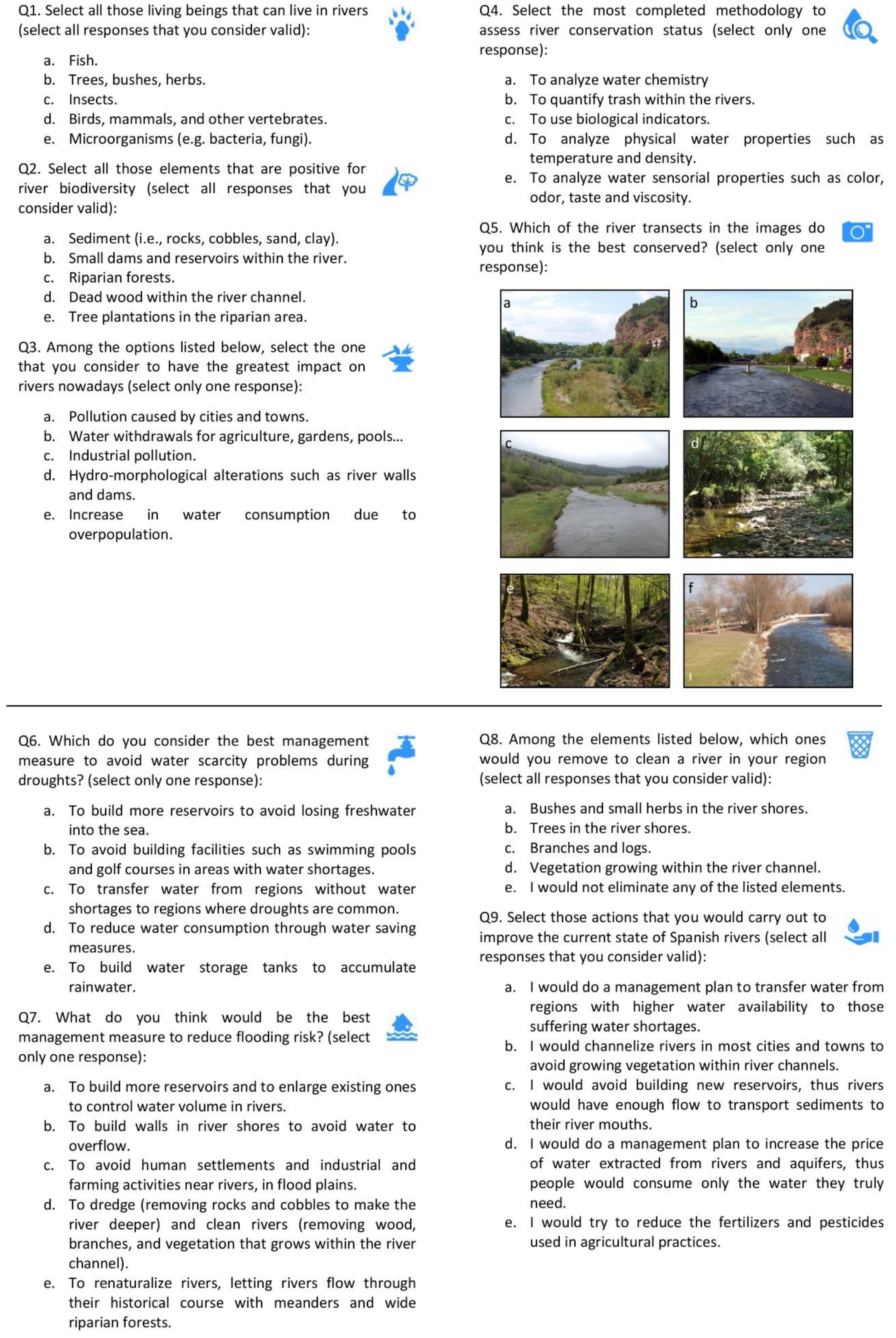
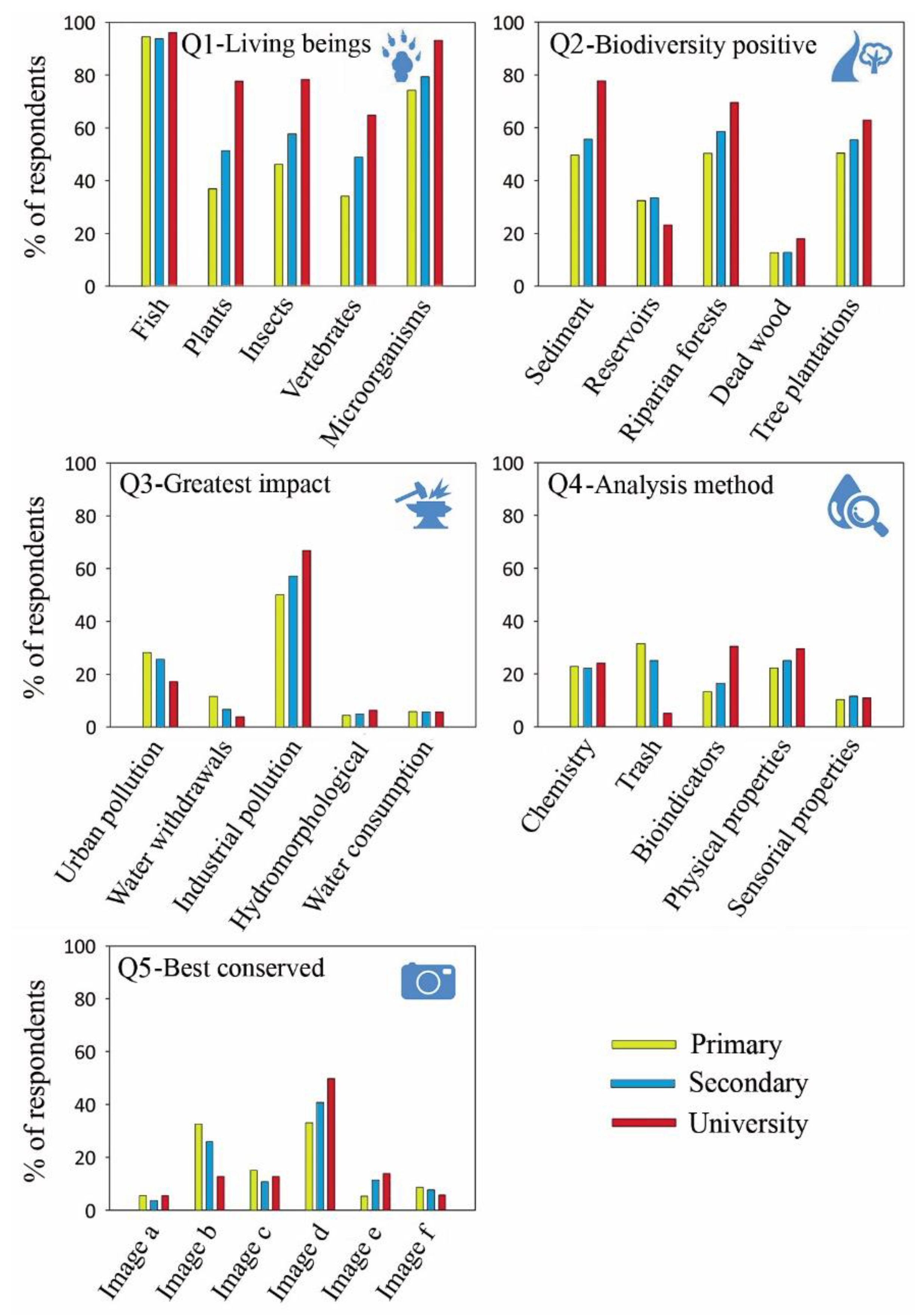
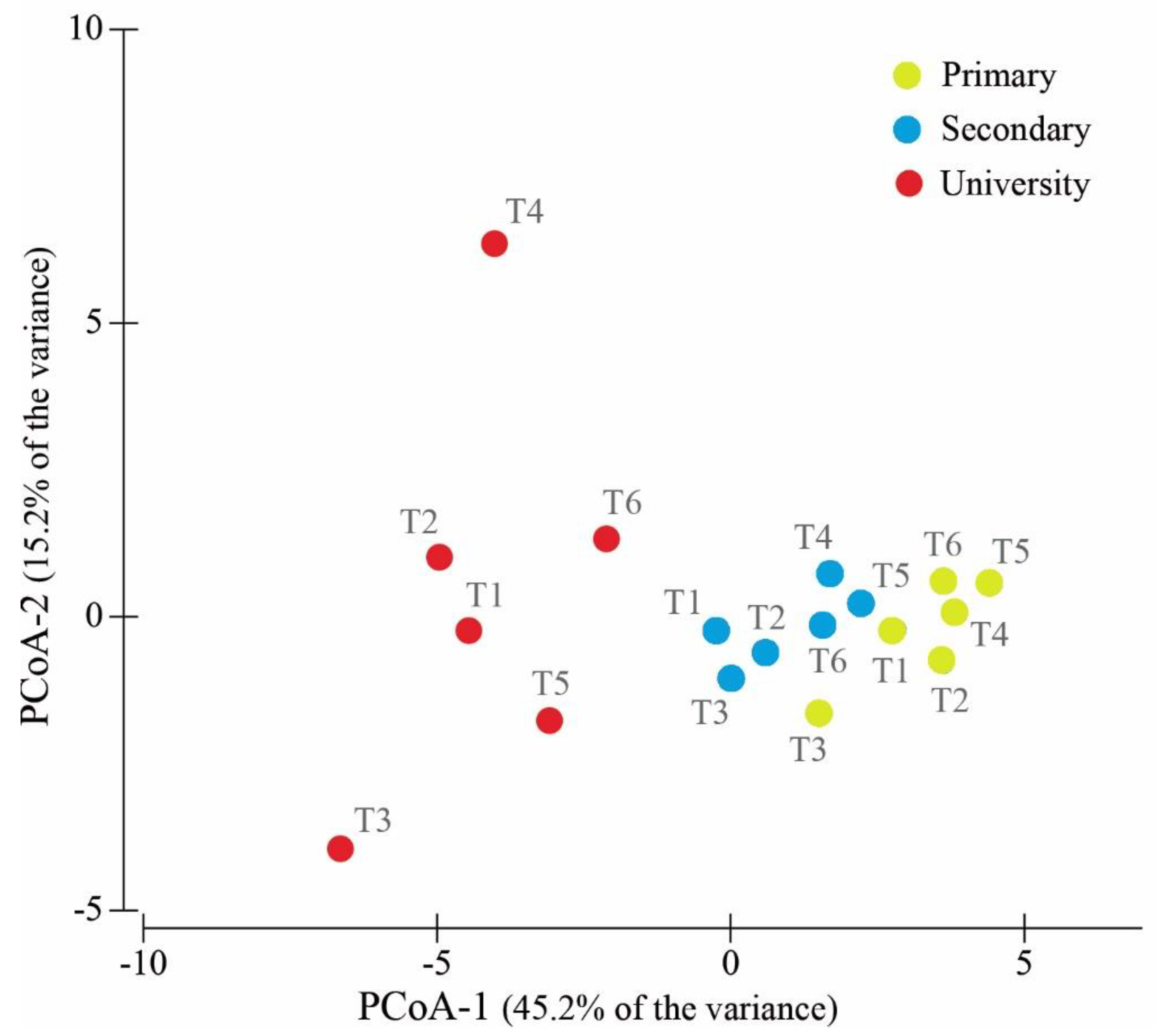
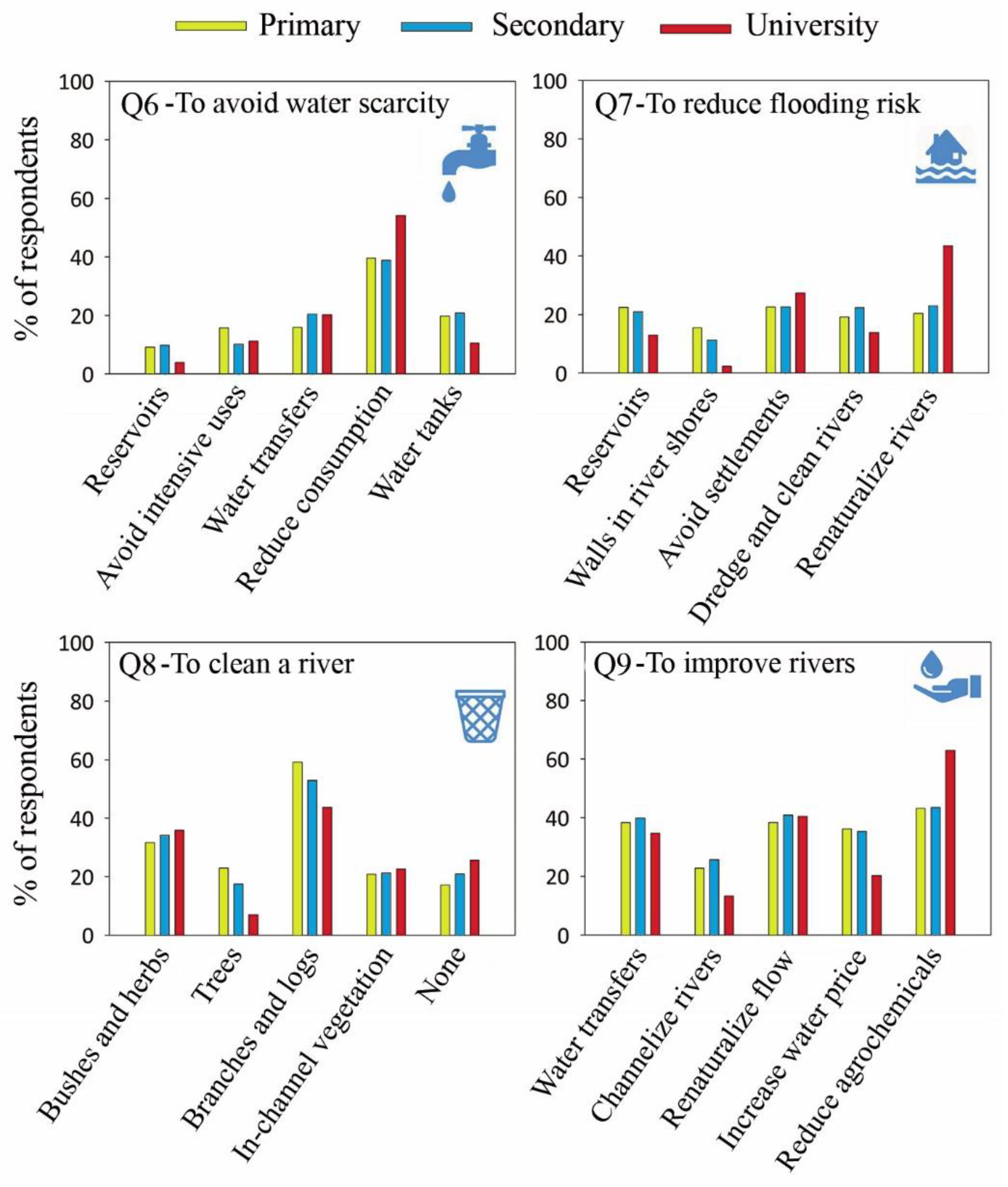
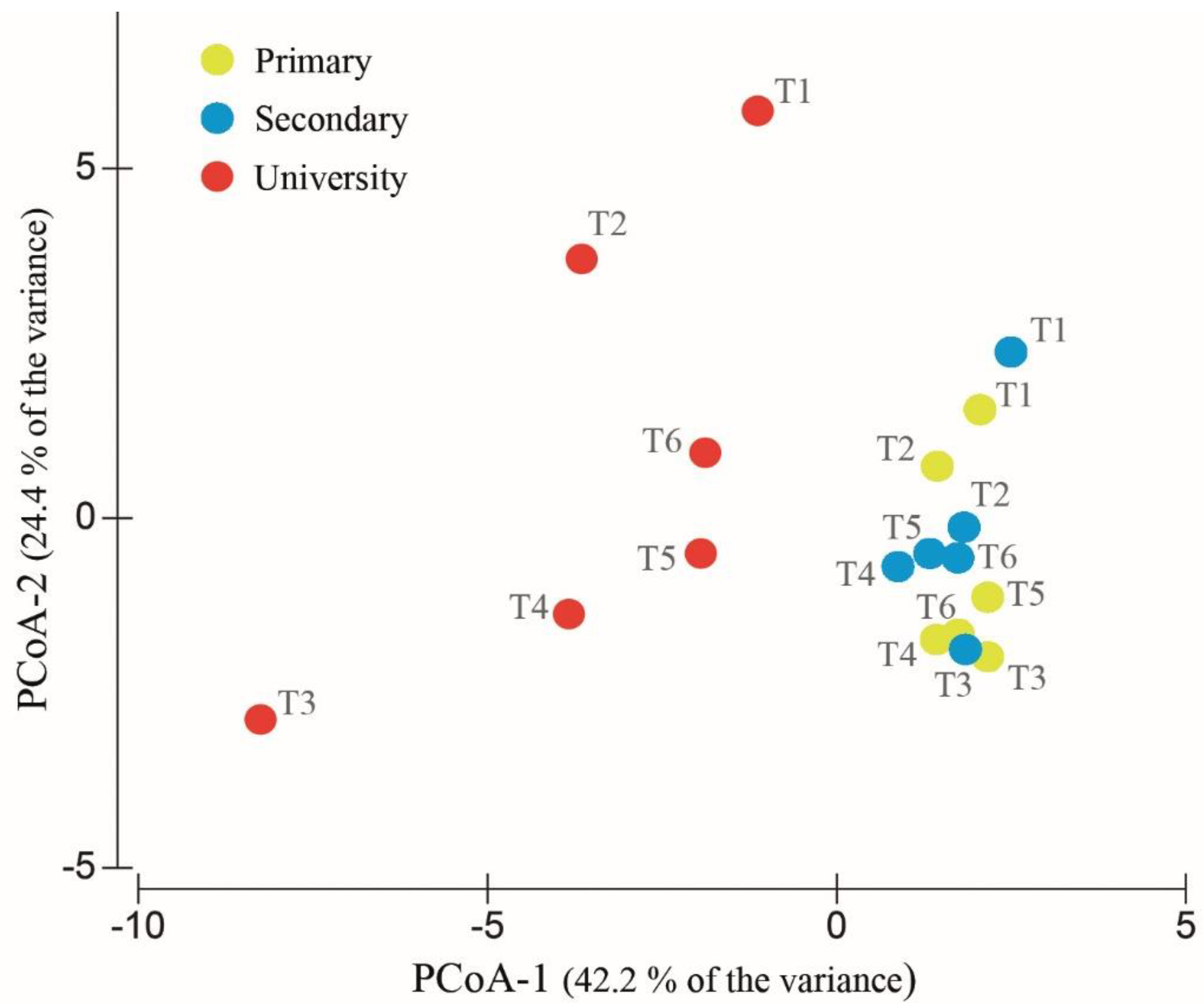
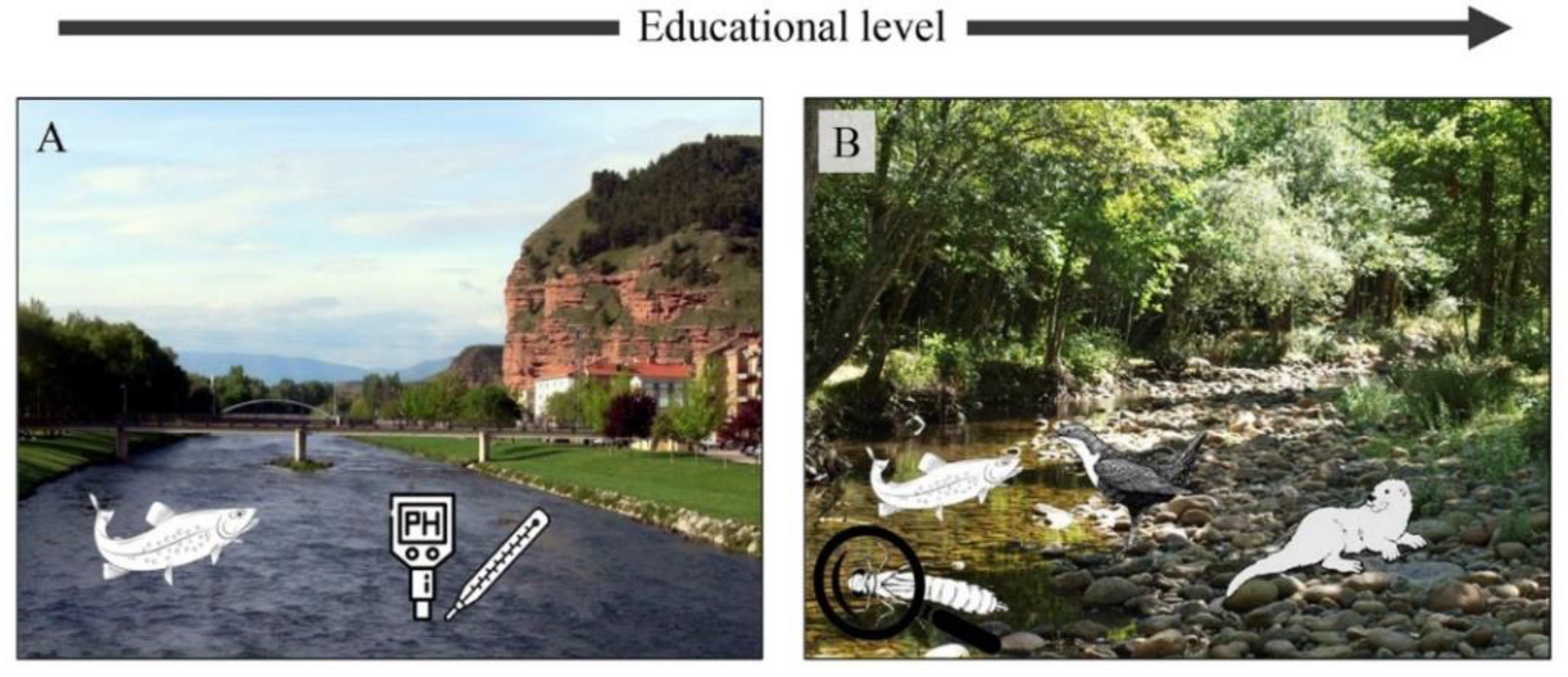
| R Spearman | Response |
|---|---|
| −0.930 | 1.d. Living beings that inhabit rivers: Birds, mammals, and other vertebrates. |
| −0.917 | 1.b. Living beings that inhabit rivers: Trees, brushes, herbs. |
| −0.911 | 2.c. Elements that are positive for river biodiversity: Riparian forests. |
| −0.901 | 2.a. Elements that are positive for river biodiversity: Sediment (i.e., rocks, cobbles, sand, clay). |
| −0.866 | 4.c. Best methodology to assess river conservation status: Bioindicators. |
| −0.864 | 1.e. Living beings that inhabit rivers: Microorganisms (e.g., bacteria, fungi). |
| −0.837 | 5.d. Image of the best-conserved river transect: Image d, well-conserved headwater stream. |
| −0.829 | 1.c. Living beings that inhabit rivers: Insects. |
| −0.707 | 2.e. Elements that are positive for river biodiversity: Tree plantations in the riparian area. |
| 0.750 | 3.a. Greatest impact on rivers nowadays: Pollution caused by cities and towns. |
| 0.865 | 4.b. Best methodology to assess river conservation status: To quantify trash. |
| 0.934 | 5.b. Image of the best-conserved river transect: Image b, urban stream after a “cleaning” action. |
| R Spearman | Response |
|---|---|
| −0.835 | 9.e. General management measure: Reducing fertilizers and pesticides in agriculture. |
| −0.760 | 7.c. Best measure to reduce flooding risk: Renaturalize rivers. |
| 0.706 | 7.b. Best measure to reduce flooding risk: Walls in river shores. |
| 0.730 | 9.b. General management measure: Channelizing rivers in cities and towns. |
| 0.782 | 9.d. General management measure: Increasing water price to reduce consumption. |
| 0.834 | 7.d. Best measure to reduce flooding risk: Dredging and cleaning. |
Publisher’s Note: MDPI stays neutral with regard to jurisdictional claims in published maps and institutional affiliations. |
© 2020 by the authors. Licensee MDPI, Basel, Switzerland. This article is an open access article distributed under the terms and conditions of the Creative Commons Attribution (CC BY) license (http://creativecommons.org/licenses/by/4.0/).
Share and Cite
Ladrera, R.; Rodríguez-Lozano, P.; Verkaik, I.; Prat, N.; Díez, J.R. What Do Students Know about Rivers and Their Management? Analysis by Educational Stages and Territories. Sustainability 2020, 12, 8719. https://doi.org/10.3390/su12208719
Ladrera R, Rodríguez-Lozano P, Verkaik I, Prat N, Díez JR. What Do Students Know about Rivers and Their Management? Analysis by Educational Stages and Territories. Sustainability. 2020; 12(20):8719. https://doi.org/10.3390/su12208719
Chicago/Turabian StyleLadrera, Rubén, Pablo Rodríguez-Lozano, Iraima Verkaik, Narcís Prat, and José Ramón Díez. 2020. "What Do Students Know about Rivers and Their Management? Analysis by Educational Stages and Territories" Sustainability 12, no. 20: 8719. https://doi.org/10.3390/su12208719
APA StyleLadrera, R., Rodríguez-Lozano, P., Verkaik, I., Prat, N., & Díez, J. R. (2020). What Do Students Know about Rivers and Their Management? Analysis by Educational Stages and Territories. Sustainability, 12(20), 8719. https://doi.org/10.3390/su12208719







